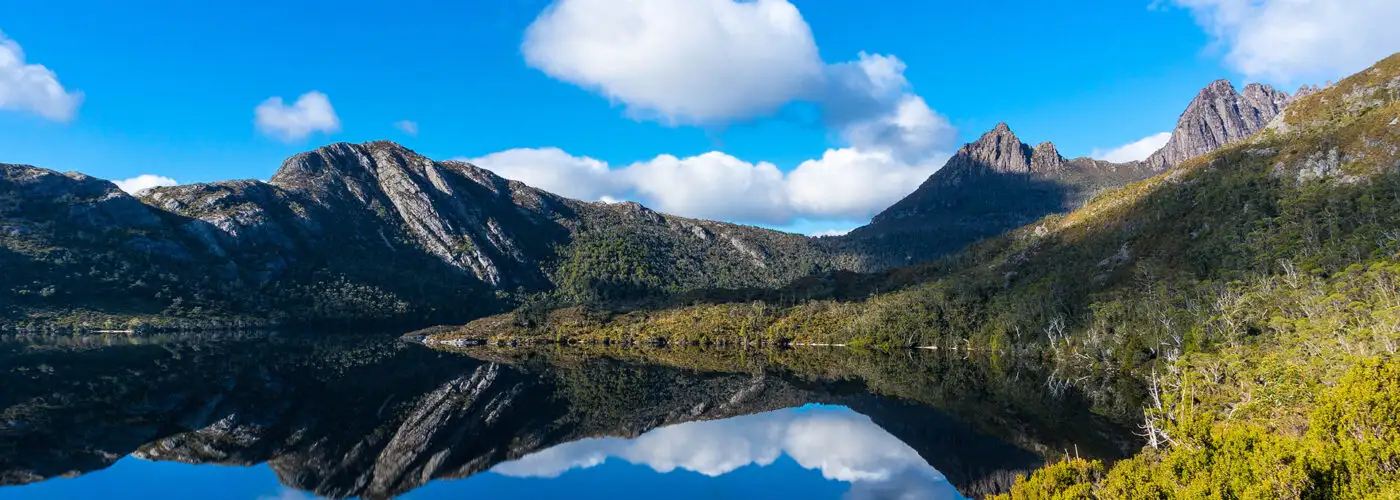It was mid-afternoon on Maria Island, a wildlife haven off the coast of Tasmania, Australia. A group of visitors was waiting for a ferry back to mainland Tasmania after a day of hiking and spotting kangaroos, wombats, and Cape Barren geese. But the island had one last surprise to serve up: a Tasmanian devil.
These small carnivorous marsupials may be the unofficial mascot of Tasmania, but they’re mostly active at night and therefore very difficult to spot in the wild; I hadn’t yet seen one during the entire week I’d been traveling around Tasmania. And yet here was one in the flesh, scampering across the main road and chasing a baby wombat into its burrow in front of a dozen wide-eyed tourists.
“Wow,” said someone behind me. “Could there be a better ending?”
It was a fair question. My six-day Taste of Tasmania tour, run by Intrepid Travel, had already shown our small group some incredible things—thundering waterfalls, remote white sand beaches, and lush rainforests that felt hidden away from the world. A sighting of the state’s most famous animal felt like the ideal capstone on a trip devoted to Tasmania’s diverse natural landscapes.
Discovering Tasmania
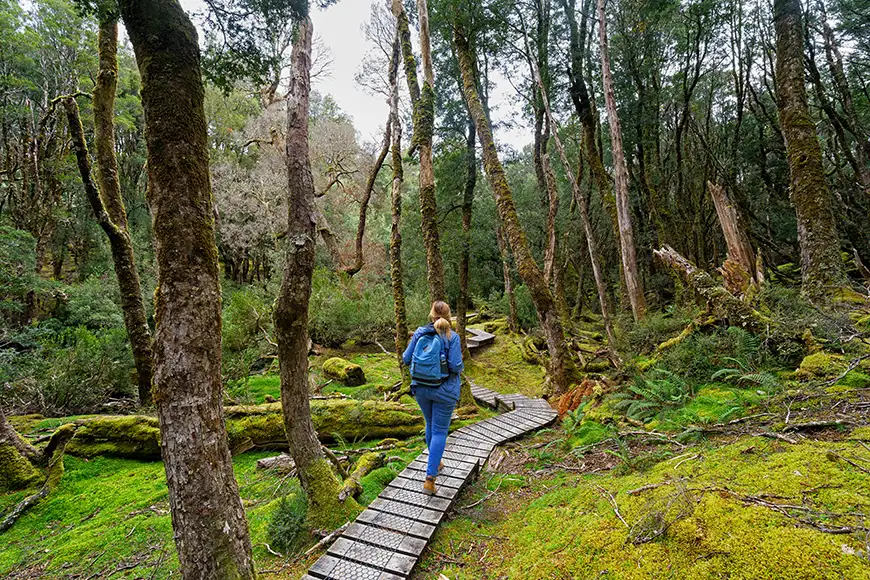
Tasmania, an island located about 150 miles south of the state of Victoria in southeastern Australia, feels far away—and that’s partly because for most of the world, it is. Fortunately, once you’ve survived the long-haul flight to Australia, Tasmania is less than two hours by air from Melbourne or Sydney. My Intrepid Travel tour departed from and returned to Hobart, a former penal colony that now serves as the state capital.
With some 40 percent of the state protected in national parks and reserves, the rugged landscape is the primary appeal of Tasmania travel (though despite this protection, the logging of old-growth forests is still a threat). Intrepid’s nature-intensive itinerary visits half a dozen national parks and includes at least one hike every day.
Tasmania’s Wild West

The first day of our journey took us from Hobart to Strahan (pronounced “Strawn”), on Tasmania’s west coast. According to our guide, western Tasmania gets some three meters of rain (about 118 inches) a year, while the east coast gets only about 800 millimeters (31 inches). As we crossed the state, we saw it all—brilliant sunshine, gloomy clouds, drizzles, downpours, and even a bit of sleet and snow—with changes often just a few minutes apart. At times our van’s windows fogged over with condensation, until one enterprising passenger bought a squeegee that we passed from window to window for the rest of the trip.
All that rain may be inconvenient to hike or drive through, but it creates southwestern Tasmania’s deep-green temperate rainforests, where waterfalls cascade into rushing rivers. Two of the most accessible waterfalls are Russell Falls (part of Mount Field National Park) and Nelson Falls (part of Franklin-Gordon Wild Rivers National Park), each of which can be reached via short, family-friendly trails in 20 minutes or less.
The hike to Montezuma Falls, Tasmania’s highest waterfall, requires a little more effort. The mostly flat trail takes three hours round-trip along a former rail line, past tree ferns and rock walls carpeted with moss. At the end you can view the falls from a narrow metal suspension bridge that sways gently as people pass over it. While you can fully appreciate the falls’ height from the bridge, you’ll also want to take the little boardwalk path to a side viewing point to appreciate the falls’ power: Here you can feel the cool spray on your face as the water thunders down before you.
Other highlights from our time in western Tasmania included the stark beauty of Henty Dunes, a vast stretch of sand sculpted by the Roaring Forties winds that blow all the way from South America, and Donoghys Lookout, a gentle hiking trail leading to expansive views of the Franklin River valley and the mountain peaks beyond.
Want more expert tips and vacation inspiration? Subscribe to SmarterTravel on YouTube!
The Cradle of the Island
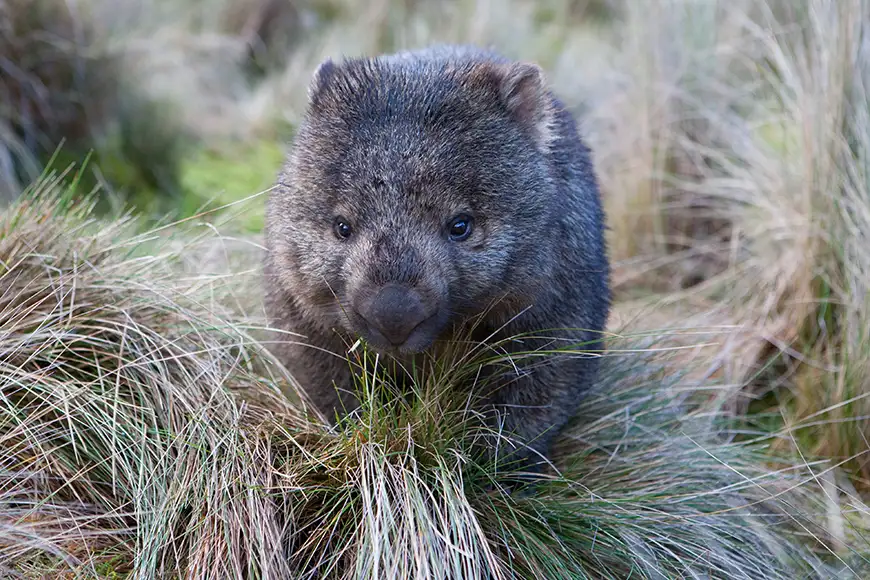
After two chilly, damp days in and around Strahan, we began working our way east with a stop at Cradle Mountain-Lake St. Clair National Park. Here we had multiple hiking options; most of the group made the challenging climb to Marion’s Lookout for panoramic views over the region’s lakes and mountains—including the famous jagged peak of Cradle Mountain itself.
I chose the easier Dove Lake Circuit, which circles the lake at the base of Cradle Mountain and offers a pleasant walk over gravel paths, boardwalks, and rocks with only one hilly section. Along the way were numerous viewpoints and picnic areas looking over the lake.
On our way out of the park, we stopped to walk along the boardwalk at Ronny Creek, which runs through a field of buttongrass where wombats often graze. We got an up-close view of one mother wombat with a joey in her pouch, its little face poking out between her hind legs.
Life on the Road with Intrepid Travel
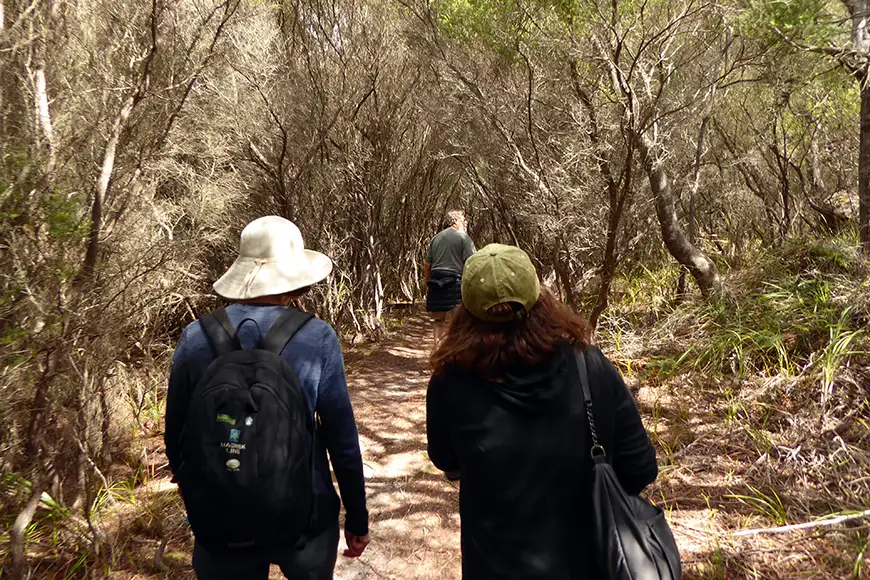
By this point in the trip, we’d fallen into the rhythm of life on tour. Each day started with continental breakfast at the hotel (included in the trip cost), followed by an early departure—no later than 8:00 a.m. We’d stop in the morning at a bakery to grab coffee and purchase a sandwich to eat on the day’s hike. Dinners were on our own, aside from a couple of optional communal meals.
Accommodations on this trip were clean and comfortable—typically motels with Wi-Fi that might or might not work at any given time. Some members of our group had booked a “Basix” version of the tour and were staying in hostels rather than motels.
Transportation was in a 20-person van, which could get tooth-jarringly bumpy over some of Tasmania’s more remote roads. Fortunately, we were never in the van longer than two hours at a time at any point during the tour—and normally we’d only have an hour to 90 minutes between walks, scenic viewpoints, or food/coffee/bathroom breaks. (The van did not have a toilet onboard.)
Our trip leader served as both guide and driver, giving a clear rundown of what to expect from each of Tasmania’s hikes so we could choose the appropriate option for our interests and fitness level. He also offered a handful of key facts about the area’s history, wildlife, or landscape as we approached each stop. Some members of the group would have preferred more in-depth commentary, while others felt satisfied with the basics. The guide was happy to take follow-up questions from those who wanted to learn more.
Intrepid Travel is an environmentally responsible tour operator that offsets the carbon emissions for all of its trips, including Taste of Tasmania. It’s also investing in a project to restore Tasmania’s endangered kelp forests.
Eastern Beaches: Bay of Fires and Wineglass Bay

The second half of our trip brought us abundant sunshine along Tasmania’s east coast. The highlight of day four was a stop at Bay of Fires Conservation Area, a series of stunning bays and white sand beaches running from larapuna to Binalong Bay. The area was given its English name by Captain Tobias Furneaux, a British navigator who spotted Aboriginal fires on its beaches in 1773. The Aboriginal people who lived here called the area larapuna, but they were killed or forced from their ancestral home by European settlers in the early 19th century.
Today, Bay of Fires is marked by soft white sand beaches and massive granite boulders covered in red-orange lichen. Peek into the tidepools to see starfish, anemones, periwinkle snails, and seaweed moving sinuously in the currents.
Just down the coast is a stretch of sand spectacular enough to land it on numerous “best beaches” lists. Wineglass Bay, part of Freycinet National Park, isn’t easy to reach: You have to climb about 40 minutes, mostly uphill, to reach the lookout point over the beach, and then climb down about 1,000 steps to get onto the sand itself. That means, of course, that you’ll have to climb back up the steps to return to the parking lot. Alternatively, you can continue along a lengthy but beautiful trail past Hazards Beach and around the headland—a total hike of about seven miles.
For those who are able, Wineglass Bay is worth the trek. The beach is long enough that it never feels crowded, and the water is a pure, shimmering aquamarine. Keep an eye out for dolphins cruising by in the waves just offshore.
For those who aren’t up for the hike, Wineglass Bay Cruises will take you on a relaxing half-day journey through the bay for scenic views and wildlife sightings, including whales, seals, dolphins, and seabirds.
Noah’s Ark: Maria Island
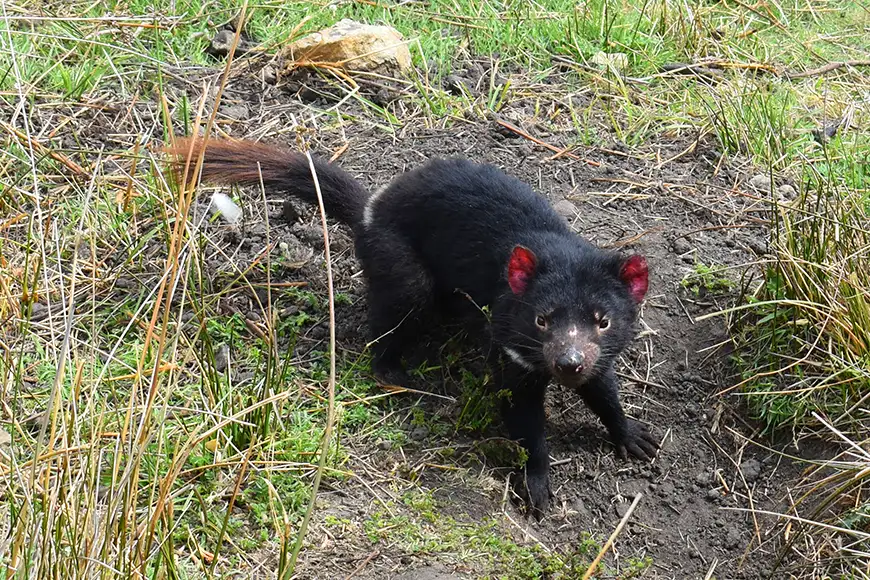
Accessible only by a 30-minute ferry ride from the town of Triabunna, Maria Island (pronounced “Mariah”) was once the site of a convict probation station and is now a wildlife sanctuary and national park. It’s often called the Noah’s Ark of Tasmania because of how many animals have been introduced to its protected shores.
For example, when Tasmanian devils in other parts of the state began falling victim to a facial tumor disease, healthy animals were brought to Maria Island to help save the species. Other transplanted animals that you’re likely to see as you hike around Maria Island include kangaroos, wallabies, wombats, and Cape Barren geese.
Our group did two short walks on the island—one to the Painted Cliffs, a wall of stunning sandstone cliffs banded with a mix of gold, brown, and cream swirled together like a cappuccino. The other was to the Fossil Cliffs, where clams, scallops, and other fossilized sea life have been preserved in sedimentary rock.
It was after we had returned to the visitor center and were watching a video about the Tasmanian devils on the island that we were alerted to the presence of a real-life devil on the road outside. After it dashed into the wombat burrow, we lined up nearby in case it decided to come back out.
Our hopes were rewarded a few minutes later. The devil emerged from the burrow to see a row of tourists waiting for it with phones and cameras at the ready. It paused and blinked inquisitively up at us as if to ask, “Where did you all come from?” Then it raced off down the path and out of sight—one last memorable moment in a journey full of them.
More from SmarterTravel:
- 12 Underrated Beach Towns in Australia
- Top 25 Ways to Save on Australia Travel
- Tipping in Australia: The Australia Tipping Guide
Sarah Schlichter was hosted by Intrepid Travel. Follow her on Twitter @TravelEditor for more travel tips and inspiration.
We hand-pick everything we recommend and select items through testing and reviews. Some products are sent to us free of charge with no incentive to offer a favorable review. We offer our unbiased opinions and do not accept compensation to review products. All items are in stock and prices are accurate at the time of publication. If you buy something through our links, we may earn a commission.
Related
Top Fares From
Today's Top Travel Deals
Brought to you by ShermansTravel
France: 8-Night Paris, Avignon & Nice...
Infinity Worldwide Vacations
 vacation
$2880+
vacation
$2880+
Poconos: 3 Nts in Garden of...
ResortsAndLodges.com
 hotel
$305+
hotel
$305+
7-Nt Canada & New England Cruise,...
Princess Cruises
 cruise
$839+
cruise
$839+
